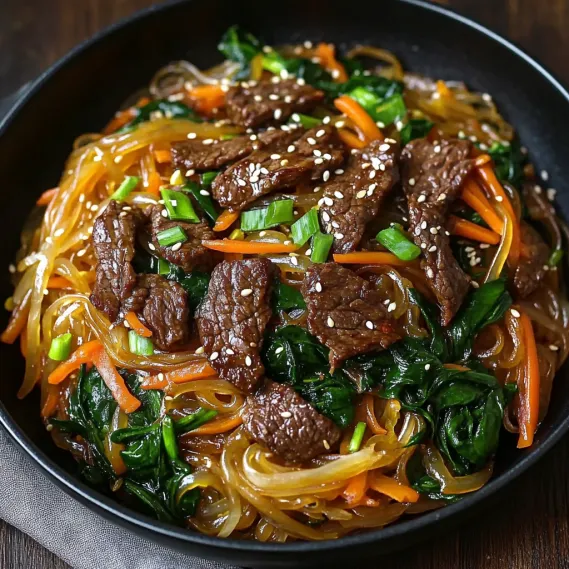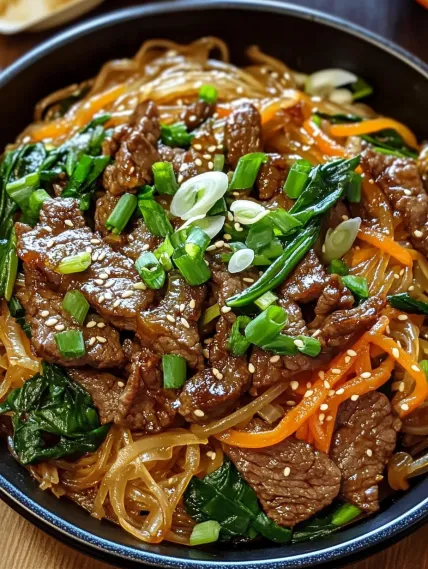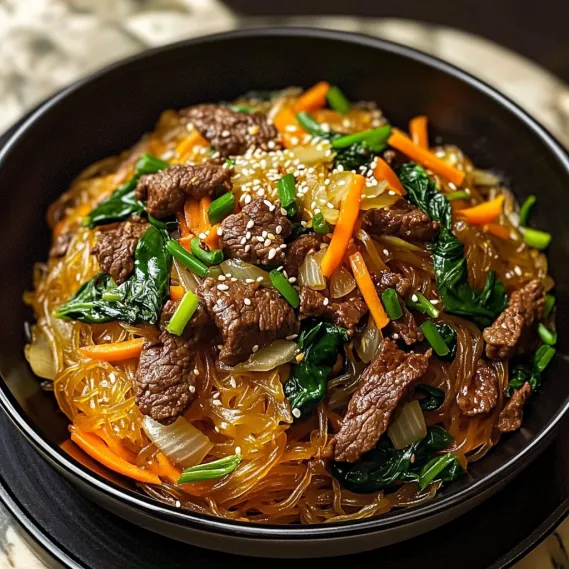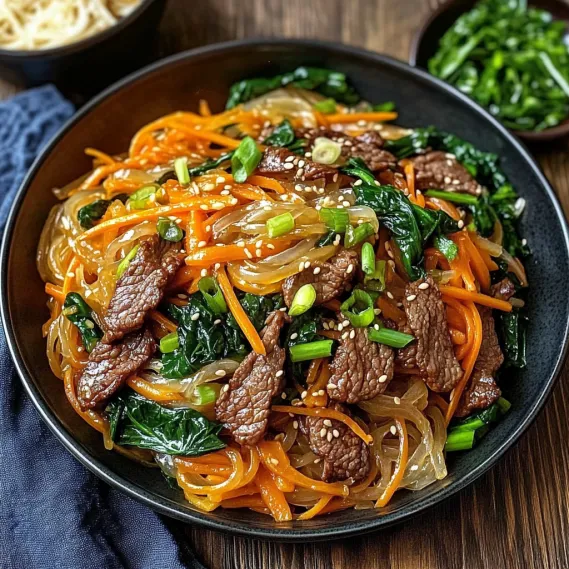 Pin it
Pin it
This traditional Korean dish features chewy sweet potato glass noodles stir-fried with tender beef, colorful vegetables, and a perfect balance of savory soy sauce and aromatic sesame oil. Each bite offers a delightful combination of textures and flavors that's both satisfying and nourishing. I discovered this recipe during my exploration of Korean cuisine and was immediately captivated by its beautiful presentation and incredible taste.
Last weekend, I served this at a family gathering and even my pickiest relatives went back for seconds. The secret? Taking time to cook each component separately before combining them maintains each ingredient's perfect texture and flavor.
Essential Ingredients and Selection Tips
- Sweet Potato Glass Noodles: Look for "dangmyeon" at Asian markets; their chewy texture is essential
- Beef: Thinly sliced ribeye or sirloin work best; pre-sliced bulgogi beef is perfect
- Sesame Oil: Use pure toasted sesame oil for authentic flavor; its nutty aroma is irreplaceable
- Fresh Vegetables: The combination of carrots, spinach, and green onions creates traditional color balance
- Soy Sauce: Naturally brewed varieties offer better depth of flavor than chemically produced ones
The magic happens when these ingredients come together with the noodles, which absorb the flavors while maintaining their delightful bouncy texture.
Detailed Cooking Instructions
- Step 1: Prepare the Noodles
- Bring a large pot of water to boil with a drizzle of olive oil. Add sweet potato noodles and cook for 5-6 minutes until chewy but tender. Drain immediately and rinse under cold water to stop cooking. Toss with a teaspoon of sesame oil to prevent sticking.
- Step 2: Season and Cook the Beef
- Heat a large skillet over high heat. Season thin-sliced beef with half the soy sauce, sesame oil, and brown sugar. Stir-fry quickly until just browned but still tender, about 2-3 minutes. Remove from pan and set aside to prevent overcooking.
- Step 3: Prepare Vegetables Separately
- In the same skillet, heat olive oil over medium-high heat. Add julienned carrots and sliced onions, cooking until just softened but still slightly crisp, about 3-4 minutes. Season with some of the remaining soy sauce mixture.
- Step 4: Add Aromatics
- Add minced garlic and most of the green onions (save some for garnish). Stir-fry for just 30-60 seconds until fragrant but not browned. Garlic burns easily and becomes bitter if overcooked.
- Step 5: Wilt the Spinach
- Add spinach to the vegetable mixture and toss quickly just until wilted, about 30 seconds. The residual heat will continue cooking it, so remove from heat while still bright green.
- Step 6: Combine Components
- In a large bowl, combine the cooked noodles, beef, and vegetable mixture. Pour remaining sauce ingredients (soy sauce, sesame oil, brown sugar) over everything.
- Step 7: Toss Thoroughly
- Use tongs or chopsticks to lift and mix all ingredients until thoroughly combined and the noodles have absorbed the sauce flavors. This may take several minutes of tossing for best results.
- Step 8: Final Seasoning
- Taste and adjust seasoning if needed with more soy sauce, sesame oil, or sugar to achieve the perfect balance of flavors based on your preference.
- Step 9: Rest Briefly
- Let the mixture sit for 5 minutes before serving to allow flavors to meld and noodles to fully absorb the sauce.
- Step 10: Garnish and Serve
- Transfer to a large serving platter and sprinkle with reserved green onions. Serve warm or at room temperature.
 Pin it
Pin it
I learned the importance of cooking each component separately from a Korean friend's grandmother, who insisted this was the secret to restaurant-quality japchae at home.
The Cultural Significance
Japchae holds deep cultural importance in Korean cuisine, dating back to the 17th century during the Joseon Dynasty. Originally created to please King Gwanghaegun at a royal banquet, it was first made without noodles, focusing on vegetables alone. Over centuries, sweet potato glass noodles became the star ingredient, transforming japchae into the beloved dish we know today. In Korean households, this colorful dish symbolizes prosperity and is served at special celebrations like weddings, Lunar New Year (Seollal), and harvest festivals (Chuseok). Understanding this rich history makes every bite more meaningful.
 Pin it
Pin it
Nutritional Balance
What I particularly appreciate about japchae is its remarkable nutritional balance. The sweet potato noodles provide complex carbohydrates that digest slowly, giving sustained energy without blood sugar spikes. With its rainbow of vegetables – carrots rich in beta-carotene, iron-packed spinach, and antioxidant-loaded onions – each serving delivers a spectrum of vitamins and phytonutrients. The beef provides protein and iron, while sesame oil offers heart-healthy fats. This harmonious combination exemplifies traditional Korean wisdom about balanced eating, where flavors, textures, and nutritional benefits work together perfectly.
Serving Suggestions
While japchae can stand alone as a complete meal, it truly shines as part of a larger Korean spread. I love serving it alongside kimchi, whose tangy spiciness provides the perfect contrast to japchae's subtle sweetness. For a proper Korean feast, consider adding bibimbap (mixed rice bowl), pajeon (savory pancake), or bulgogi (marinated grilled beef). Japchae is traditionally served at room temperature or slightly warm rather than piping hot, allowing the flavors to fully develop. This makes it perfect for buffet-style serving at gatherings since it doesn't need to be kept hot.
Customization Options
The versatility of japchae is what makes it a staple in my kitchen. While the traditional recipe uses beef, I've created wonderful variations with chicken, pork, shrimp, or tofu for vegetarian guests. Mushrooms make an excellent meat substitute, with shiitakes bringing a particularly satisfying umami flavor. For additional vegetables, bell peppers add vibrant color, zucchini provides tender texture, and bean sprouts contribute delightful crunch. Those who enjoy spice can add gochujang (Korean chili paste) or thinly sliced fresh chilies. Each variation maintains the dish's essence while allowing for personal preference and seasonal ingredients.
Chef's Essential Tips
- Cut all vegetables into similar-sized strips for even cooking and elegant presentation
- For authentic flavor, use Korean or Asian pears in the beef marinade if available
- Add a tablespoon of honey instead of brown sugar for a more complex sweetness
- Toast sesame seeds before sprinkling on top for enhanced nutty flavor
- Use kitchen scissors to cut the long noodles into more manageable lengths after cooking
I've refined these techniques over years of making japchae, particularly after visiting Korea and experiencing the dish in its homeland.
This beautiful noodle dish has become my go-to for gatherings where I want to impress without spending the entire day in the kitchen. The colorful presentation always draws compliments, and the unique texture of the glass noodles provides a delightful introduction to Korean cuisine for those unfamiliar with it.
 Pin it
Pin it
This recipe honors traditional Korean culinary practices while being accessible to home cooks everywhere. It's a perfect example of how food bridges cultures and brings people together through shared enjoyment of flavors that satisfy across all boundaries.
Frequently Asked Questions
- → Where can I find Korean sweet potato noodles?
- You can find these glass noodles (dangmyeon) at Asian grocery stores, Korean markets, or online. Look for packages labeled 'sweet potato starch noodles' or 'Korean glass noodles.'
- → Can I make this dish vegetarian?
- Absolutely! Simply omit the beef and add more vegetables like mushrooms, bell peppers, or zucchini. You can also add firm tofu for protein.
- → How do I store leftover japchae?
- Store in an airtight container in the refrigerator for up to 3 days. Reheat gently in a pan with a splash of water or in the microwave. Japchae is also delicious served cold or at room temperature.
- → Are there any traditional vegetables I should include?
- Traditional japchae often includes shiitake mushrooms, bell peppers, and sometimes cucumber. Feel free to add these for a more authentic version.
- → Why are my noodles sticking together?
- To prevent sticking, rinse the noodles well with cold water after cooking and toss them with a little sesame oil. Don't overcook them - they should be chewy, not mushy.
